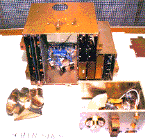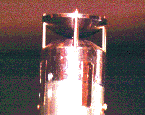|
Two of the seven SCIFER instruments were developed at MSFC. These were the STICS (Scanning Thermal Ion Composition Spectrometer), and the TECHS (Thermal Electron Capped Hemisphere spectrometer). Both were developed through collaboration between Marshall's Space Sciences and Astrionics Laboratories.

View of the STICS instrument during construction.
The STICS measures the 3D thermal distribution functions of Hydrogen, Helium, and Oxygen ions and has flown successfully on three previous sounding rocket flights in the nightside auroral ionosphere, where ion outflows also occur.

Closeup of TECHS instrument and deployment system.
The TECHS represents a new technology for measurement of the 3D ionospheric thermal electron distribution function. From the thermal distribution functions, species density, temperature, and flow may be derived, and non-equilibrium features may be identified and used to diagnose operative plasma energization processes.

The SCIFER rocket payload during integration procedures.
Preliminary indications are that two high-quality and richly-detailed data sets have been obtained with these instruments on SCIFER. These data promise to provide significant insight into the physics of ionospheric plasma fountain formation. Quantitative computer analysis of the telemetered data, amounting to over 1000 MegaBytes, will be required to understand and assimilate the observations that have been obtained.
The SCIFER project has been a scientific collaboration among Cornell University, NASA/MSFC, the Norwegian Space Centre, University of Alabama in Huntsville, University of Alaska, University of New Hampshire, University of Oslo, University of Tromsoe, and University of Texas at Dallas.
|
